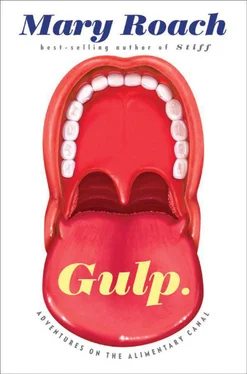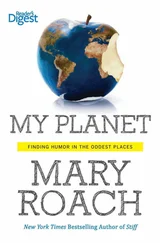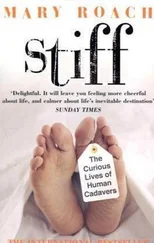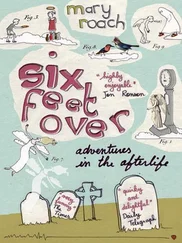What happened here? Hirschsprung’s disease. As J.W.’s embryonic self was laying down nerves along the length of the colon, the process petered out. The final stretch was left without. As a result, peristalsis—the wave of contraction and dilation that moves things through the gut—stops right there. Digesta pile up until the pressure builds to a point where it shoves things through. The shove might happen every few days, or it might take weeks. Just behind the dead zone, the colon becomes overstretched and damaged—a floppy, passive, swollen thing. The megacolon may eventually take up so much room that it begins to bully other organs. Taking a deep breath is a struggle. J.W.’s heart and lungs were thrust upward and outward to the point where they pushed the ribs aside and began jutting horizontally from the torso.
Without surgery, a megacolon like J.W.’s will prevail. If the specimen is spectacular enough, it finds its way to a museum, earning a toehold in medical history while the man himself fades to obscurity. This was the case, too, with the megacolon of a Mr. K., written up in the Journal of the American Medical Association in 1902. In a photograph that accompanies the article, the organ lies on what appears to be a hospital bed, as though it grew so big that it eventually eclipsed Mr. K. entirely and the doctors and nurses took to caring for it in his place, changing the sheets, bringing meals on trays, putting bendy straws in its ginger ale. All we know about poor Mr. K. is that he lived in Groton, South Dakota. Everything else has been subsumed by the details of the autopsy and a frightful chronology of doctor-assisted evacuations. From a medical aside, we glean that Mr. K. had a family and that they seemed to care about him: “June 22, the report was received that he had passed an ordinary pailful of feces…. There was much rejoicing in the family.”
Anna Dhody, the Mütter Museum curator, led me down to the basement [112] This was less exciting than it sounds because Dhody keeps the “creepy-tastic” stuff out on display. For example, the necklace of dried hemorrhoids, and the jar of skin (dropped off by the roommate of a compulsive picker, in a Trader Joe’s strawberry preserves jar with a note attached: “Please recycle,” presumably referring to the jar).
to see what we could learn about J.W. the man. The file holds a reprint of a paper presented at the College of Physicians of Philadelphia on April 6, 1892, by Henry Formad, Demonstrator of Morbid Anatomy. On top of overseeing the “rather voluminous autopsy,” Formad had interviewed J.W.’s mother. The woman recalled that “disturbances in defecation” and abdominal swelling had been evident by age two, suggesting Hirschsprung’s. J.W. began working at sixteen, first in a foundry and later a refinery. All the while, his belly continued to swell. In a photograph taken shortly before he died, he stands in a doctor’s wood-floor examining room, naked except for hospital slippers, baggy white socks, and a few days’ growth of beard. He looks directly at the camera with a demeanor of calm defiance. Imagine the biggest potbelly, the longest overdue triplets, on a meager frame of knobby limbs. The bastard offspring of Humpty Dumpty and Olive Oyl. To better capture the great torso on film, the photographer had instructed J.W. to raise one hand to his head. The cheesecake pose invites you to stare, but everything else says, Look away.
By the age of twenty, J.W.’s physique had grown so peculiar that he was hired by a freak show in Philadelphia’s old Ninth and Arch Museum. The museum’s first floor housed carnival-style tests of strength and fun-house mirrors, and I imagined J.W. hanging around those mirrors on his breaks, positioning his girth just so and taking in the bittersweet sight of himself as a normally proportioned man. J.W. was exhibited under the carnival name Balloon Man, along with the Minnesota Woolly Baby [113] Oddly, the exhibit chosen for billboarding on the building’s exterior was “Young Women Basketball Players.”
and an assortment of other human and animal oddities.
Formad made no reference to J.W.’s emotional state other than to note that he was unmarried and, justifiably, given to drink.
YOU DON’T NEED a megacolon to fall victim to “defecation-associated sudden death,” but it helps. At the age of twenty-nine, J.W. was found dead on the floor of the bathroom at the club where he regularly took his dinners. The autopsy report described the death as instantaneous, but there was no evidence of a heart attack or a stroke. Likewise, our Mr. K. died at 2 A.M. while straining, as they say, at stool.
“That’s what killed Elvis,” said Adrianne Noe. Noe is the director of the National Museum of Health and Medicine, which has its own megacolon, from an unknown party. As we were about to get off the phone, Elvis Presley dropped into the conversation. Noe related that she’d been standing by the megacolon exhibit one day and a visitor told her that Elvis had had one too. The man added that Presley had struggled with constipation his whole life and that as a child his mother Gladys had had to “manually disimpact” him. “He said that’s why Elvis was so close to his mother.”
A quiet moment followed. “Really.”
“That’s what he said.”
I had heard that Presley died on the toilet, but I’d assumed the location was happenstance, as it was with Judy Garland and Lenny Bruce: an embarrassing setting for a standard celebrity overdose. But the straining-at-stool theory made some sense. With all three autopsies—that of J.W., Mr. K., and E., as Presley’s intimates called him—the collapse was abrupt and the autopsy revealed no obvious cause of death. (Though Presley had traces of several prescription drugs in his blood, none was present at a lethal level.) What Elvis’s autopsy did unambiguously reveal was a colon two to three times normal size.
At the time it happened, no one pinned Presley’s death on his colon or efforts to empty it. It wasn’t until years later that Dan Warlick, the coroner on the case, came forward with the megacolon/straining-at-stool theory. Presley’s longtime doctor, George “Nick” Nichopoulos, was an eager adopter of Warlick’s theory. Nichopoulos had been vilified for overprescribing prescription drugs, and many fans blamed him for Presley’s death. He wrote a memoir and made himself available to talk to the press. Few seemed inclined to listen. The reference I came across was on a website hawking herbal constipation remedies. A short piece headlined “Elvis Died of Constipation” had run as the site’s lead story (and its middle and last story) under the category Constipation News.
Why didn’t the colonic inertia theory come up earlier? Nichopoulos says that at the time, he had never heard of it. Nor had the gastroenterologist who treated Presley in the 1970s. “Nobody knew about it back then,” Nichopoulos says.
I recall reading in one of Charles Tyrrell’s books that advances in medical knowledge about the colon had, historically, been hobbled by the organ’s repulsiveness. Eighteenth- and nineteenth-century dissectors and anatomy instructors would, he claimed, promptly cut the lower bowel out of the cadaver and throw it away, “on account of its scent-bag propensities and nastiness.” Michael Sappol, a historian with the National Library of Medicine who has written extensively on the history of anatomy, said he’d heard this too. Leading me to wonder: Does distaste slow progress in treating diseases of the bowel? Does the excretion taboo discourage research, discussion, media attention?
I recall riding a bus in San Francisco, years ago, and seeing a public service ad about anal cancer, “the cancer no one talks about.” I had never heard of it, and in the decade and a half since then, I haven’t come upon another reference. Until I looked it up, while writing this paragraph, I didn’t realize Farrah Fawcett had died of anal cancer. There were references to her ailment as cancer “below the colon.” It was like my mother, when I was a kid, calling the vagina “your bottom in front.” Up through 2010, anal cancer had no nonprofit society, no one to organize fund-raisers and outreach, no colored awareness ribbon. (Even appendix cancer has a ribbon.) [114] It’s amber. Because there are more cancers than colors, awareness ribbons are like paint chips now: Stomach cancer is periwinkle, ovarian is teal. Colon and rectal cancer are plain blue. They used to be brown (just as the color for bladder cancer awareness is yellow), but some patients objected. A mistake, I say. They could have had brown all to themselves; blue they have to share with Epstein-Barr, osteogenesis imperfecta, victims of hurricane Katrina, drunk driving, acute respiratory distress syndrome, child abuse, baldness, and secondhand smoke.
Like cervical cancer, anal cancer is caused by the human papillomavirus; people get it via sex with an infected person, and that seems like something they ought to know when making decisions about using a condom.
Читать дальше












